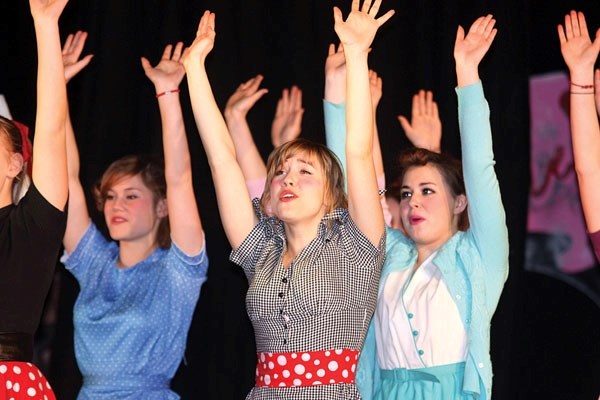The hair and makeup crew behind a live production is a lot like a racecar driver’s pit crew. They must be ready as soon as an actor flies in from the stage and every precious second counts.
“I always want to videotape that moment,” said Whitney James, a volunteer with the Main Stage program at the Alberta High School of Fine Arts. “It looks hilarious back here because we’re all just hanging out and then the minute we see (the actor), it’s like go, go!”
Members of the Main Stage hair and makeup crew laughed as James, a former student teacher, described what it can be like backstage during a performance when an actor has a quick turnover before the next scene and the crew must at times change the actor’s hair, makeup and costume.
“You have to definitely work around the actors’ and actresses’ needs of how long they have and what else they have to do off stage,” explained Grade 11 technical theatre student Rayleen Sloan.
Sloan said she likes being able to transform people into something totally different.
Crew members, along with all other students and staff involved in Main Stage, are preparing for “All Shook Up,” a musical set in the 50s which features music from Elvis Presley. The first performance runs Friday.
While some of the most memorable parts of the show for audience members can be the visual appeal and how realistic characters look, a lot of hard work is put into a character’s appearance behind the curtains.
“People don’t realize how important it is,” technical theatre student Bekki Neild said about an actor’s makeup. “It just makes everyone look better. It really puts life into the show.”
Neild said the best part is being able to be creative.
“I always have the greatest time with everybody,” Neild said. “You get to know all the actors… Tech theatre in general is like a family and it makes me look forward to school.”
Sloan said an actor’s makeup is important because it helps to bring out their features.
“If they don’t have the right stuff on, it washes them out and it takes away from the reality and the life-like part of theatre,” she explained.
One of the first things audience members see when an actor walks out on stage is their physical appearance and hair and makeup help to define a character, said James.
“As an actor, I know that having hair and makeup done makes a big difference because that’s kind of the final touch and it really helps you to get into character,” she said.
Lucia Vajdova plays Matilda in the production and said if her hair is slicked back and her makeup is done to make her look older, she feels more uptight, strict and old. If she sees herself without hair and makeup done, she said she doesn’t feel like her character.
“Once you have your makeup on, you look like your expected person,” she said.
Vajdova and Will Carr, who plays Dean, agreed hair and makeup are important for actors.
“The combination of hair and makeup and costumes, it just really helps you get into character,” said Carr.
Grade 12 student Emily Gryba, who plays Sylvia, said it takes about an hour to complete her makeup and pin curls, complete with lots of hairspray and bobby pins to keep it secure while dancing.
“It’s easier to become your character when you look like it and you don’t look like yourself,” she explained.
Gryba said she researched the time period and helped to come up with her character’s appearance.
Main Stage artistic and technical director James Keary said students conducted extensive research into the time period from social status to stigmas to fashion and did assignments to help build their characters.
Costuming, hair and makeup decisions are a team effort with the hair and makeup crew creating the design and actors helping to craft who they see themselves to be with a template from their teacher to create a unified concept, Keary explained.
“That makes it more meaningful for the actors if we’ve equipped them with fashion or with a hairstyle design similar to what they’ve created for themselves,” he said.
This year’s production is more focused on dance than prior shows, which they had to take into account with hair, makeup and costume construction, Keary said.
Hair from that time period featured bouffants, flips and curls, he explained, but hairstyles for the production will be simple because of costume changes, actors playing more than one character and even one playing more than one gender.
“We need to have flexible hairstyles,” he said.
Ashlee Hegel, who teaches the school’s hairstylists apprenticeship program, said the 50s hairstyles are not too intricate, but said one main character who has multiple changes forced them to think outside the box.
“That poses a challenge,” she said. “They’re going to have to resort to a wig because just with the sweating and the changing from male to female is really quite difficult.”
Time restraints don’t allow for intricate styles and a wig could be useful in this situation, she added.
Despite the pressure resulting from the time crunch between scenes, backstage crew members seem to enjoy their roles.
To see all the hairstyles and fashions of the 1950s check out the new Main Stage performance “All Shook Up”.
“All Shook Up” runs at the high school on Feb. 3, 4 and Feb. 8 to 11, with two shows on Feb. 11. For tickets contact 403-540-6574 or [email protected].




